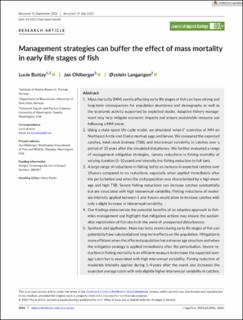| dc.contributor.author | Buttay, Lucie | |
| dc.contributor.author | Ohlberger, Jan Philipp | |
| dc.contributor.author | Langangen, Øystein Ole Gahr | |
| dc.date.accessioned | 2023-10-19T11:15:52Z | |
| dc.date.available | 2023-10-19T11:15:52Z | |
| dc.date.created | 2023-08-14T09:57:56Z | |
| dc.date.issued | 2023 | |
| dc.identifier.citation | Journal of Applied Ecology. 2023, 60 (10), 2056-2065. | en_US |
| dc.identifier.issn | 0021-8901 | |
| dc.identifier.uri | https://hdl.handle.net/11250/3097558 | |
| dc.description.abstract | Mass mortality (MM) events affecting early life stages of fish can have strong and long-term consequences for population abundance and demography as well as the economic activity supported by exploited stocks. Adaptive fishery management may help mitigate economic impacts and ensure sustainable resource use following a MM event.
Using a state-space life cycle model, we simulated ‘what-if’ scenarios of MM on Northeast Arctic cod (Gadus morhua) eggs and larvae. We compared the expected catches, total stock biomass (TSB), and interannual variability in catches over a period of 10 years after the simulated disturbance. We further evaluated a range of management mitigation strategies, namely reductions in fishing mortality of varying duration (1–10 years) and intensity (no fishing reduction to full ban).
A large range of reductions in fishing led to an increase in expected catches over 10 years compared to no reductions, especially when applied immediately after the perturbation and when the cod population was characterized by a high mean age and high TSB. Severe fishing reductions can increase catches substantially but are associated with high interannual variability. Fishing reductions of moderate intensity applied between 1 and 4 years would allow to increase catches with only a slight increase in interannual variability.
Our findings demonstrate the potential benefits of an adaptive approach to fisheries management and highlight that mitigation actions may ensure the sustainable exploitation of fish stocks in the wake of unexpected disturbances.
Synthesis and application. Mass mortality events during early life stages of fish can potentially have substantial and long-term effects on the population. Mitigation is more efficient when the affected population has a diverse age structure and when the mitigation strategy is applied immediately after the perturbation. Severe reduction in fishing mortality is an efficient measure to increase the expected average catch but is associated with high interannual variability. Fishing reduction of moderate intensity applied during 1–4 years after the event also increases the expected average catch with only slightly higher interannual variability in catches. | en_US |
| dc.language.iso | eng | en_US |
| dc.title | Management strategies can buffer the effect of mass mortality in early life stages of fish | en_US |
| dc.title.alternative | Management strategies can buffer the effect of mass mortality in early life stages of fish | en_US |
| dc.type | Peer reviewed | en_US |
| dc.type | Journal article | en_US |
| dc.description.version | publishedVersion | en_US |
| dc.source.pagenumber | 2056-2065 | en_US |
| dc.source.volume | 60 | en_US |
| dc.source.journal | Journal of Applied Ecology | en_US |
| dc.source.issue | 10 | en_US |
| dc.identifier.doi | 10.1111/1365-2664.14489 | |
| dc.identifier.cristin | 2166646 | |
| dc.relation.project | Norges forskningsråd: 280467 | en_US |
| cristin.ispublished | true | |
| cristin.fulltext | original | |
| cristin.qualitycode | 2 | |
